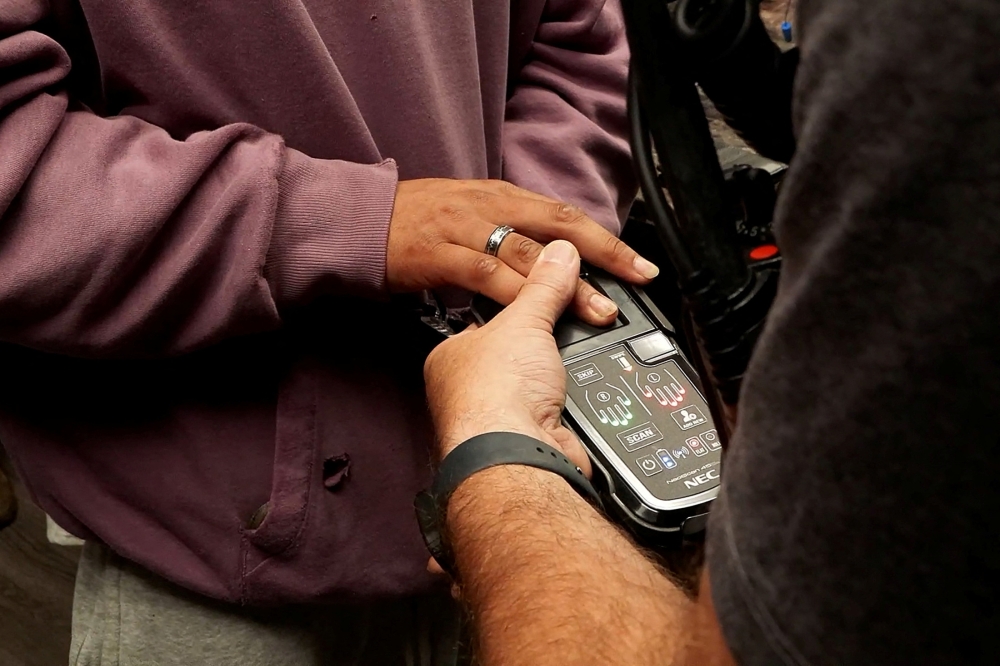WASHINGTON, June 19 — US President Donald Trump has stepped up arrests of immigrants in the US illegally, cracked down on unlawful border crossings and stripped legal status from hundreds of thousands of migrants since January 20.
Arrests
Trump won back the White House promising record numbers of deportations. A Trump administration budget document published last week said US Immigration and Customs Enforcement aimed to deport 1 million immigrants per year. ICE has cast a wider net than under former President Joe Biden’s Democratic administration, picking up more non-criminals and people with final deportation orders, including those coming to ICE offices for routine check-ins.
ICE arrested more than 100,000 people suspected of violating immigration law from January 20 to the first week of June, according to the White House. The figure amounts to an average of 750 arrests per day — double the average over the past decade.
Federal agents stand with workers during a raid by US Immigration and Customs Enforcement (ICE) at a Glenn Valley Foods meat production plant in Omaha, Nebraska June 10, 2025 in a still image from video. — US Immigration and Customs Enforcement handout pic via Reuters
Still, the pace of arrests remains far short of what Trump would need to deport millions of people. Top White House official Stephen Miller, the architect of Trump’s immigration agenda, pressed ICE to escalate operations in late May. Miller set a quota for at least 3,000 arrests per day and told ICE leadership they should target anyone without legal status. The increased enforcement led to protests in Los Angeles and other cities. ICE last week ordered officers to generally refrain from immigration sweeps at farms, hotels, restaurants and meatpacking plants, but the Washington Post reported on Monday that the agency had rescinded the order.
Detention
ICE statistics show the number of people arrested by ICE with no other criminal charges or convictions and then detained rose from about 860 in January to 7,800 this month — an increase of more than 800 per cent.
Those arrested and detained with criminal charges or convictions also rose, but at a lower rate of 91 per cent.
ICE had more than 51,000 immigrants in custody as of June 1, well beyond its funded capacity of 41,500. A sweeping tax and spending bill passed by the US House of Representatives in May would devote an estimated US$150 billion to immigration enforcement. The massive funding boost would cover a White House request for 100,000 detention beds, according to analyses of the legislation.

A worker has their fingerprints checked electronically during a raid by US Immigration and Customs Enforcement (ICE) at a Glenn Valley Foods meat production plant in Omaha, Nebraska June 10, 2025 in a still image from video. — US Immigration and Customs Enforcement handout pic via Reuters
Deportations
The Trump administration has struggled to increase deportation levels even as it has opened new pathways to send migrants to countries other than their home country, such as sending Venezuelans to Mexico, El Salvador or Panama. Trump’s border czar, Tom Homan, said in late May that the administration had deported around 200,000 people over four months. The total appeared to lag deportations during a similar period under Biden, whose administration had 257,000 deportations from February-May 2024, according to Department of Homeland Security statistics.
Biden’s administration faced much higher levels of illegal immigration and quickly deported many of those crossing illegally, boosting deportation totals.
DHS stopped issuing detailed statistical reports on immigration enforcement after Trump took office, which makes it harder to gauge the scope of the crackdown.
Stripping legal status
The Supreme Court in May allowed the Trump administration to proceed with terminating Temporary Protected Status for about 350,000 Venezuelans, paving the way for Trump to terminate it for other nations. TPS provides deportation relief and work permits to people already in the US if their home countries experience a natural disaster, armed conflict or other extraordinary event. The Trump administration rolled back a Biden-era extension of TPS for 521,000 Haitians so that it could expire in early August. The administration also ended the status for thousands of people from Afghanistan and Cameroon, moves that take effect in the coming weeks. The Supreme Court earlier this month let the Trump administration proceed with stripping legal status from half a million Cubans, Haitians, Nicaraguans and Venezuelans who entered under a Biden-era “parole” programme. Trump said in March that he was weighing a similar move to revoke parole for Ukrainians. The administration in April began notifying people who entered legally under Biden using an app known as CBP One that their status had been revoked.

A soldier walks past a warning sign marking a restricted area near the US-Mexico border, as part of the Trump administration’s crackdown on immigration and following the establishment of a 260-mile military zone along the US southern border in New Mexico and Texas, in El Paso, Texas May 22, 2025. — Reuters pic
Border security
Trump issued a series of executive orders when he returned to the White House, implementing a broad ban on asylum for migrants encountered at the southern border and sending in troops to assist border security efforts. His measures built on some initiatives already under way by the end of Biden’s tenure, including a similar asylum ban and a push to increase Mexican enforcement. The policies appear to have successfully reduced traffic. US Border Patrol arrested 8,300 migrants at the southern border in February, US government figures show, the lowest monthly level since 2000. Monthly figures are not available prior to 2000.
The number of arrests in March and April was similar, showing a sustained drop.
Migrant arrests are often used as a proxy to estimate illegal crossings although some migrants enter undetected.
The February arrest total was a steep drop from the 141,000 migrants picked up in February 2024 before Trump returned to office and down from 29,000 in January, according to US government figures. — Reuters


